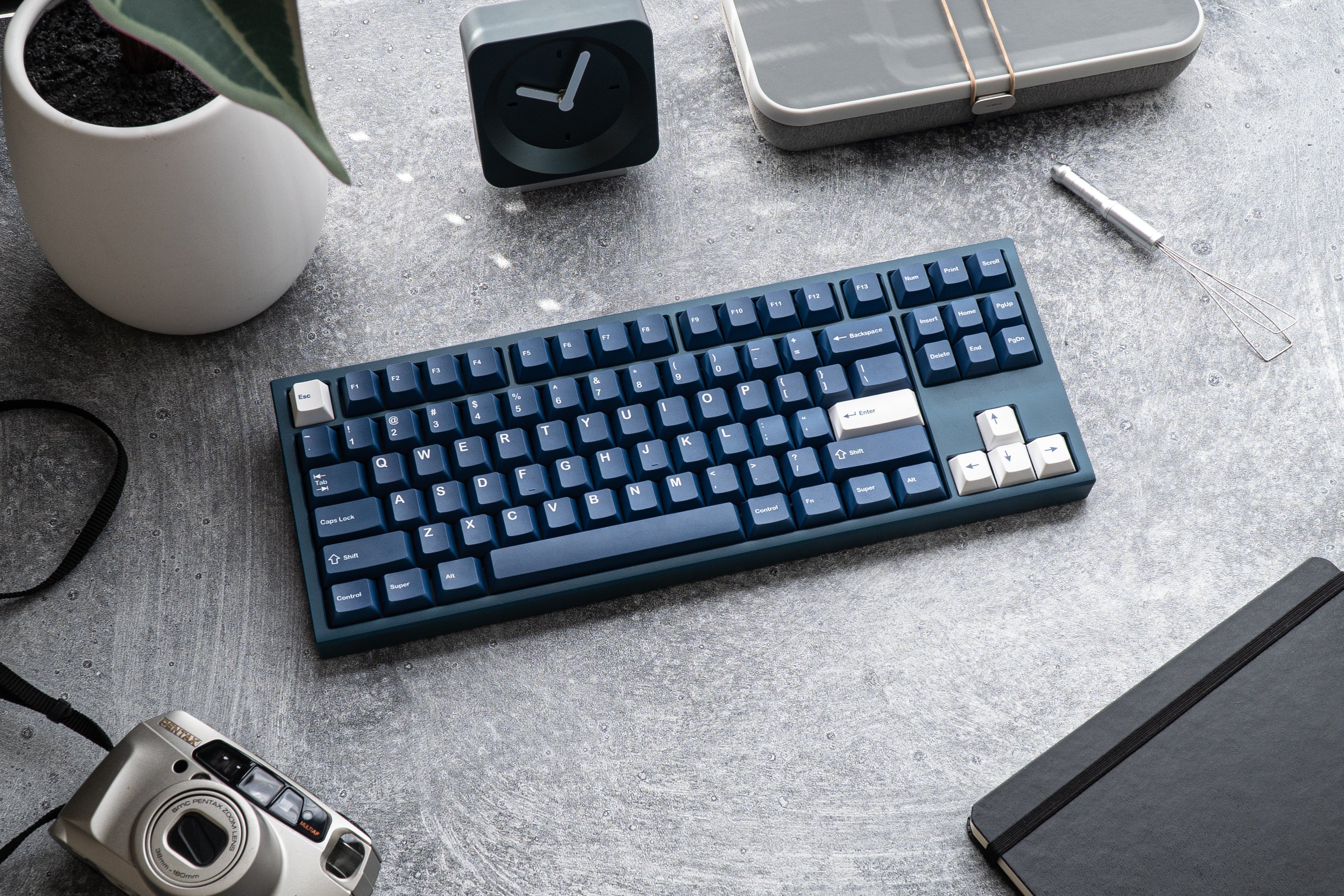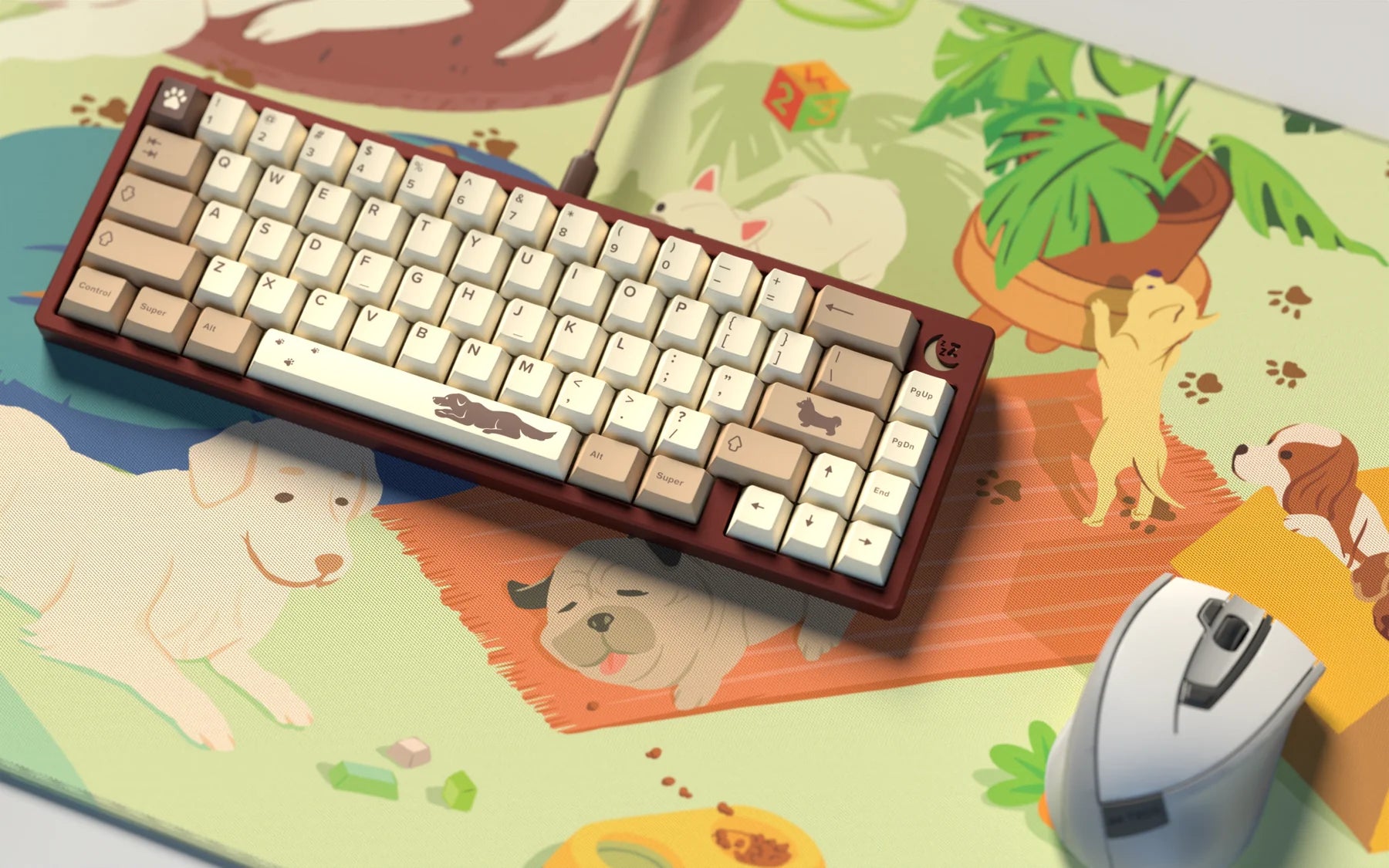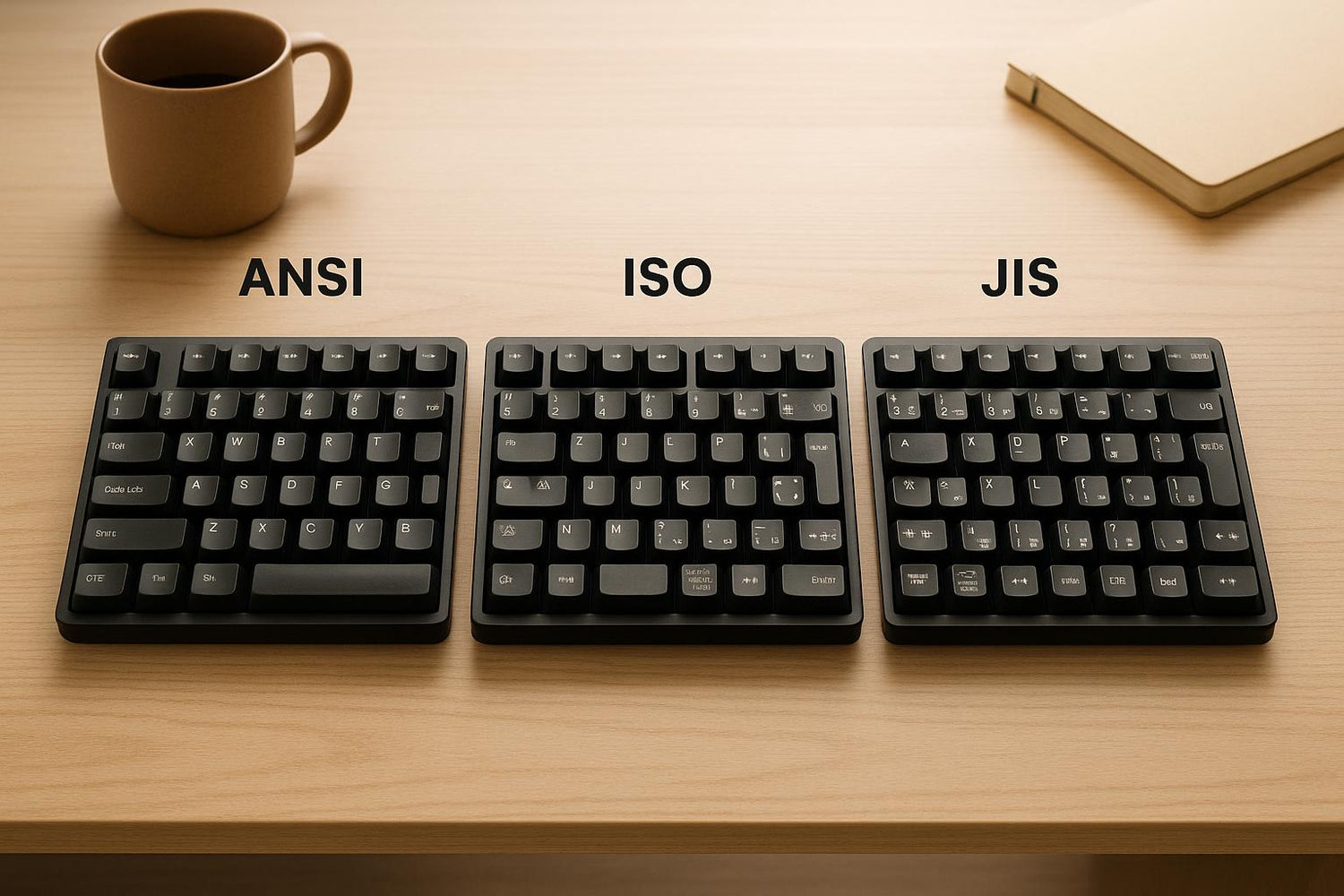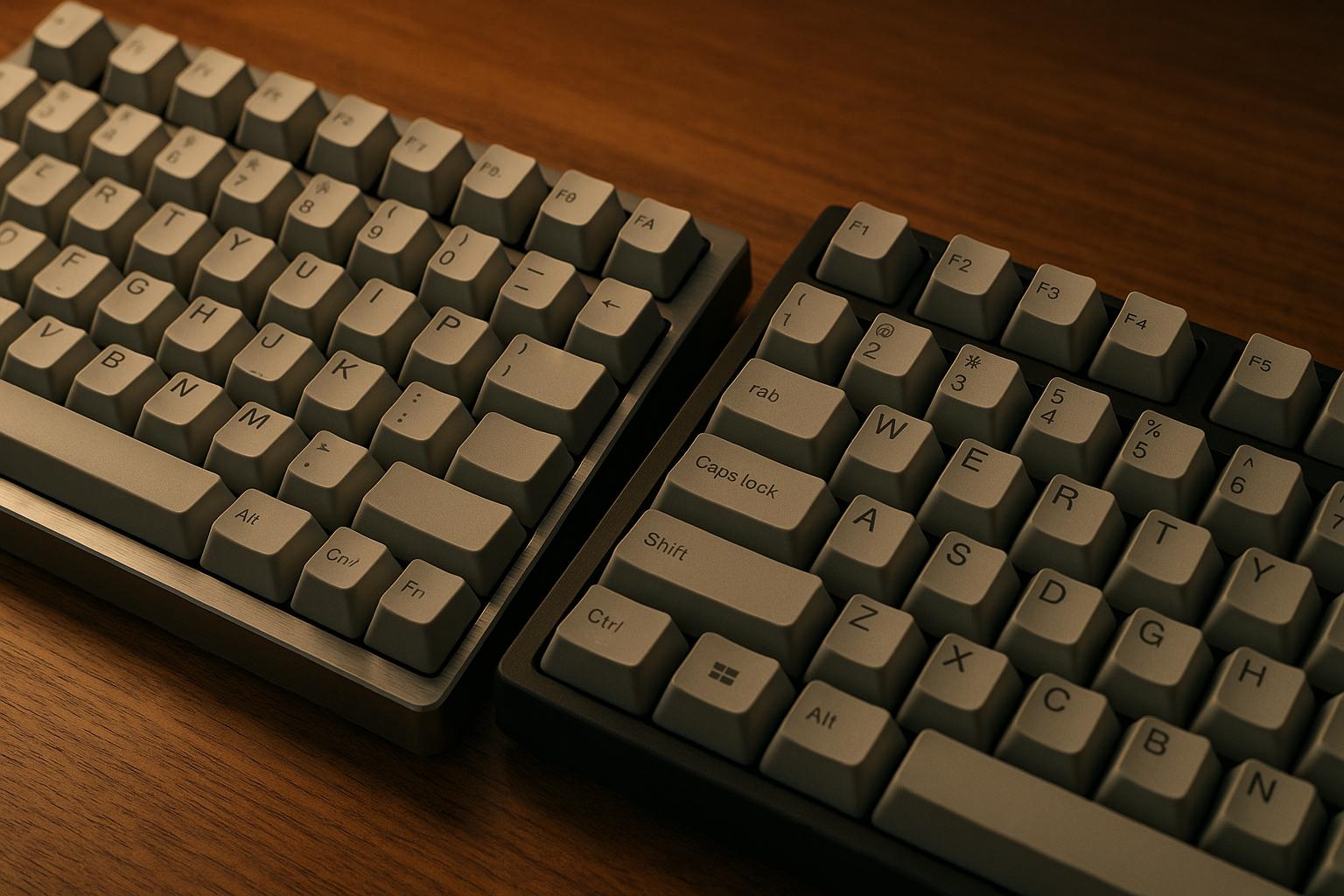When choosing a keyboard layout, it boils down to your typing needs, language preferences, and customization goals. Here’s the quick rundown:
- ANSI: Best for English typing, widely used in the U.S., and offers the most options for keycaps and components. Simple design, but limited for multilingual typing.
- ISO: Popular in Europe, ideal for typing in multiple languages, thanks to its extra key and Alt Gr functionality. Limited customization options and higher costs.
- JIS: Designed for Japanese input, with dedicated keys for kana switching and extra symbols. Great for bilingual users but harder to find and customize outside Japan.
Quick Comparison Table:
| Feature | ANSI (US) | ISO (Europe) | JIS (Japan) |
|---|---|---|---|
| Total Keys | 104 | 105 | 109 |
| Enter Key Shape | Rectangular | L-shaped | L-shaped |
| Primary Language | English | European | Japanese |
| Customization Options | High | Moderate | Low |
| Availability | Very High | Moderate | Low |
Key takeaway: If you’re in the U.S., ANSI is the simplest and most accessible choice. ISO is better for European languages, while JIS suits Japanese typing. Choose based on your location, language, and how much you want to customize.
ANSI vs ISO Keyboard Layout: Which One is Superior?
ANSI Layout: Features and Specifications
The ANSI layout, established by the American National Standards Institute, is a go-to choice for its straightforward design and compatibility with a wide range of mechanical keyboard builds.
ANSI Layout Physical Design
A full-size ANSI keyboard typically has 104 keys arranged in a rectangular layout. The Enter key is a single-row rectangle, conveniently placed under the right pinky. Just above it, you’ll find the backslash key, making it easy to reach.
The left Shift key is long and rectangular, ensuring reliable activation. Both the left and right Alt keys are identical in size and shape, creating a balanced feel along the bottom row. The keys are purposefully designed without splits or unusual shapes, keeping the layout clean and functional.
These design choices make the ANSI layout practical and user-friendly.
Best Users for ANSI Layout
Thanks to its efficient design, the ANSI layout works well for a variety of users. English typists, gamers, and professionals all benefit from its large, easy-to-use Shift and Enter keys, as well as its compatibility with a vast array of keycap sets and components. Gamers appreciate the layout’s precision and responsiveness during fast-paced gameplay, while professionals value the simplicity that reduces typing errors and strain.
At KeebsForAll, you can explore a wide selection of ANSI-compatible components and pre-owned builds. The familiar layout makes it easy to switch between different ANSI keyboards without missing a beat.
ANSI Layout Advantages and Disadvantages
The ANSI layout shines when it comes to compatibility with US software and hardware, ease of use, and the sheer variety of keycap options available. Its straightforward design is tailored for English typing and enjoys strong community support for customization projects.
That said, the layout does have its drawbacks. It offers limited support for multilingual typing, which can be frustrating if you often use characters or diacritics not found on standard English keyboards. Additionally, while ANSI keyboards are widely available in the United States, they’re harder to find in other parts of the world. This can pose challenges for users who work with international teams or travel frequently.
| Advantages | Disadvantages |
|---|---|
| High compatibility with US software and hardware | Limited multilingual support |
| Wide variety of keycaps and accessories | Less common outside the United States |
| Simple design tailored for English typing | |
| Strong community backing for customization |
Next, we’ll dive into the unique characteristics of the ISO layout.
ISO Layout: Features and Specifications
The ISO layout, established by the International Organization for Standardization, serves as the standard keyboard design across much of Europe. Its design tweaks make it a go-to choice for users needing reliable access to special characters and multilingual typing capabilities.
ISO Layout Design Differences
The ISO layout stands apart from ANSI in several key ways. First, there's the L-shaped Enter key, which extends vertically. This design not only offers a larger target area but also provides a distinct tactile experience compared to ANSI’s horizontal Enter key.
Another notable difference is the shortened left Shift key, which is about the same size as the Ctrl key. This adjustment makes room for an extra key, often used for symbols like <>, adding flexibility and customization options. While ANSI users may need time to adapt, the additional key can be incredibly functional.
The backslash key is also repositioned. Instead of sitting above the Enter key as in ANSI, ISO places it near the left Shift key. This change reduces the reach required for frequent use, making it more accessible for certain tasks.
A standout feature of ISO keyboards is the transformation of the right Alt key into Alt Gr (Alt Graph). This specialized key unlocks a third and fourth layer of characters for most keys, which is crucial for typing accented characters and symbols commonly used in European languages.
ISO keyboards typically have 105 keys, one more than the 104-key ANSI layout. This extra key is a result of the shortened left Shift design, catering to specific user needs that we’ll explore further.
Best Users for ISO Layout
The ISO layout is particularly well-suited for those who work with European languages or frequently use special characters. Writers, translators, and business professionals often rely on the Alt Gr key to type accented characters like the French é, è, and ê, the German ä, ö, and ü, or the Spanish ñ.
European users benefit from the layout’s alignment with local software standards and typing habits, making it a practical choice for those who type in native European languages. Additionally, professionals in technical fields or coding appreciate the repositioned backslash key and the extra programmable key, which can streamline certain tasks.
For those interested in ISO-compatible mechanical keyboards, KeebsForAll offers a variety of components. The KFA Marketplace at kfamarketplace.com also features pre-owned ISO keyboards from third-party sellers, giving users access to assembled builds that may be harder to find in new condition.
ISO Layout Advantages and Disadvantages
The ISO layout shines in areas like multilingual support and ergonomics. The Alt Gr key simplifies typing in European languages, and the L-shaped Enter key can improve comfort for some users.
However, there are challenges. Limited keycap availability is a common issue, especially when sourcing parts from US-based vendors. The smaller demand for ISO layouts often translates to higher costs and longer wait times for replacements or upgrades.
For those transitioning from ANSI, the learning curve can be steep. Adjusting to the L-shaped Enter key and the shorter left Shift key takes time. Additionally, some software may not fully support the extra keys or the Alt Gr functionality, leading to potential compatibility issues.
| Advantages | Disadvantages |
|---|---|
| Excellent support for European languages | Limited keycap and component options |
| Alt Gr key for quick access to special characters | Adjustment period for ANSI users |
| Improved ergonomics with the L-shaped Enter key | Higher costs due to niche market |
| Widely used in European countries | Potential software compatibility challenges |
| Fewer keyboard models available |
When deciding between ISO and other layouts, it ultimately comes down to your language needs and whether you're willing to adapt to a design tailored to a more specialized audience.
sbb-itb-3cb9615
JIS Layout: Features and Specifications
The JIS layout, much like ANSI and ISO, is uniquely crafted to meet regional needs - specifically, it’s built to support Japanese language input while still allowing smooth English typing. This makes it a practical choice for bilingual users who frequently switch between the two languages.
JIS Layout Design Elements
The JIS layout includes 109 keys, which is five more than the ANSI layout and four more than ISO. This extra functionality is achieved through a split spacebar and two additional keys near the Enter key. These added keys are specifically designed for toggling between hiragana, katakana, and Roman characters, as well as accessing punctuation and symbols unique to Japanese writing.
Despite these additions, the layout retains the familiar QWERTY arrangement for Roman letters and numbers. Many keys are dual-labeled, making it easier for users to type in both Japanese and English. These thoughtful design features make the layout particularly useful for those who need to type in both languages regularly.
Best Users for JIS Layout
The JIS layout is an excellent fit for Japanese typists and bilingual users. Its dedicated keys for switching between character sets make it an efficient tool for handling Japanese input. In Japan, JIS keyboards are the standard in schools, offices, and government institutions, ensuring a consistent typing experience across various settings.
Professionals like translators, international business workers, and students learning Japanese benefit greatly from the layout. It allows direct hardware-based access to Japanese characters, eliminating the lag sometimes associated with software-based input methods.
JIS Layout Advantages and Disadvantages
To summarize the layout’s strengths and weaknesses, here’s a closer look at what makes the JIS layout stand out - and where it falls short.
The JIS layout is optimized for Japanese typing, offering dedicated keys for switching character sets and accessing language-specific symbols. For native Japanese users, the design feels natural and efficient.
That said, its specialization comes with trade-offs. Since global demand is limited, manufacturers prioritize ANSI and ISO layouts, making JIS keyboards harder to find outside Japan. This can lead to higher costs, potential software compatibility issues in non-Japanese environments, and a steeper learning curve for those accustomed to ANSI or ISO layouts.
| Advantages | Disadvantages |
|---|---|
| Tailored for Japanese language input | Limited availability outside Japan |
| Easy access to kana and special symbols | Higher costs due to niche market |
| Smooth character set switching | Possible software compatibility issues |
| Standard in Japanese professional settings | Difficult for users unfamiliar with JIS |
| User-friendly for native Japanese speakers | Fewer options for keycaps and components |
While the JIS layout excels at meeting the needs of those who type primarily in Japanese, its specialized design may not be the best fit for users who primarily rely on English.
Layout Comparison and Selection Guide
When deciding on a keyboard layout, it's essential to weigh the differences between ANSI, ISO, and JIS. These layouts aren't just about looks - they shape your typing experience in significant ways.
ANSI vs ISO vs JIS Comparison Chart
Here's a quick breakdown of the key differences between these layouts. Each impacts how you type, customize, and interact with your keyboard.
| Feature | ANSI (US) | ISO (Europe) | JIS (Japan) |
|---|---|---|---|
| Total Keys | 104 | 105 | 109 |
| Enter Key Shape | Rectangular | L-shaped | L-shaped |
| Left Shift Key | Long | Short | Short |
| Backslash Key Location | Above Enter | Near Left Shift | Swapped with Backspace |
| Spacebar | Long | Long | Short |
| Primary Language Support | English | European languages | Japanese |
| Component Availability | Very High (US/Global) | Moderate (Europe) | Low (Japan only) |
| Keycap Options | Extensive | Limited | Very Limited |
The chart highlights how these layouts affect keycap compatibility and availability, which are crucial for those who want to customize their keyboards.
How to Choose Your Keyboard Layout
Choosing the right layout depends on three main factors: your primary language, where you live, and your customization preferences.
- Primary Language: If you mostly type in English, ANSI is the most straightforward option with its familiar key arrangement. ISO is better suited for European languages, offering an extra key for accented characters and symbols. JIS, on the other hand, is ideal for Japanese typists, featuring dedicated keys for character switching and dual-labeled keycaps.
- Geographic Location: Your region can influence both software compatibility and hardware availability. ANSI is the standard in the U.S., ISO aligns with European systems, and JIS works best within Japanese setups. Using a layout outside its native region might require additional software tweaks.
- Customization Goals: ANSI is the go-to choice for keyboard enthusiasts due to its widespread availability and market support. For instance, the Freebird series from KeebsForAll offers "Multi Layout Support", allowing flexibility in physical arrangements. However, even with flexible PCBs, finding keycaps for ISO and JIS layouts can be challenging and often limits customization options.
Switching layouts also comes with a learning curve. Moving from ANSI to ISO means adjusting to a shorter left Shift key and a different punctuation setup. Transitioning to JIS involves learning new key functions and input methods, which can take time even with software remapping.
Lastly, there’s the cost factor. ANSI components are generally more affordable due to their popularity and larger production runs. Meanwhile, ISO and JIS parts can be pricier because of limited production and import costs.
If you're looking for broad compatibility and affordability, ANSI is your best bet. ISO is perfect for multilingual typists, while JIS caters specifically to Japanese input needs. KeebsForAll provides components tailored to each layout, ensuring you can find what suits you best.
Conclusion: Selecting Your Keyboard Layout
The keyboard layout you choose plays a big role in your typing experience, customization options, and overall usability. As we've discussed, your decision impacts not only how comfortable and efficient your setup is today but also how adaptable it will be in the future.
If you're in the US, ANSI is the go-to choice. It offers the broadest compatibility, a huge range of keycap options, and works seamlessly with most software. Whether you're building your first custom keyboard or planning future upgrades, ANSI’s accessibility makes it a practical and reliable option.
For those who type in multiple languages, ISO is a solid alternative. While it comes with fewer customization options and higher costs, it’s a logical pick if language support is a top priority.
JIS, on the other hand, is specifically designed for Japanese input. Unless you’re typing in Japanese regularly, it’s probably not the best fit due to its added complexity and the scarcity of components.
In short, ANSI users benefit from an abundance of keycap options and easy-to-find parts through retailers like KeebsForAll. ISO and JIS users, however, may face limited choices and higher costs. Keep in mind, switching layouts later can mean a steep relearning curve and added expense. Matching your layout to your language needs and typing habits is key to creating a setup that lasts.
For most US users, ANSI offers the best balance of compatibility and convenience. If multilingual typing is your focus, go with ISO. And if Japanese input is your priority, stick with JIS.
FAQs
What are the differences between ANSI, ISO, and JIS keyboard layouts, and how do they impact typing?
The ANSI, ISO, and JIS keyboard layouts each bring their own unique key placements, sizes, and functionalities, influencing how comfortable and efficient typing can feel. Here's a quick breakdown:
- ANSI (American National Standards Institute): This layout is the go-to choice in the United States. It features a single-row Enter key and an easily accessible left Shift key, making it familiar and straightforward for most American users.
- ISO (International Organization for Standardization): Common in Europe, this layout includes a vertical Enter key and a slightly shorter left Shift key, catering to European typing norms.
- JIS (Japanese Industrial Standard): Primarily used in Japan, this layout stands out with extra keys for language switching and unique symbols, tailored for Japanese text input.
When deciding on a layout, think about your location and typing habits. For those in the U.S., ANSI will likely feel the most natural. If you're accustomed to European keyboards, ISO might be a better fit. And for anyone frequently typing in Japanese, JIS is the clear winner. Trying out these layouts can help you discover which one aligns best with your preferences and typing style.
How can I choose the right keyboard layout for my language and typing style?
Choosing the right keyboard layout comes down to your language, typing style, and what feels most natural to you. The three most widely used layouts - ANSI, ISO, and JIS - each serve different regions and typing needs.
- ANSI (American National Standards Institute): This layout is the go-to choice in the United States. It’s designed with a smaller Enter key and works perfectly for English typing.
- ISO (International Organization for Standardization): Common in Europe, this layout features an extra key near the Enter key, making it suitable for various European languages.
- JIS (Japanese Industrial Standards): Specifically tailored for Japanese users, this layout includes additional keys to accommodate language-specific characters.
When deciding, think about the languages you type in and which layout feels most intuitive. If you're venturing into the world of custom mechanical keyboards, shops like KeebsForAll offer a variety of parts compatible with these layouts, allowing you to create a setup that matches your preferences.
What challenges might I face switching from an ANSI layout to ISO or JIS, and how can I adapt?
Switching from an ANSI keyboard layout to ISO or JIS can take some getting used to, mainly because of the differences in key placement and sizes. For instance, the ISO layout features a larger Enter key and changes the positioning of keys like Shift and Backslash. The JIS layout, on the other hand, adds extra keys specifically for Japanese characters and functions. If you're accustomed to the compact setup of ANSI, these differences might take a bit of adjustment.
The best way to adapt is by practicing with the new layout consistently, even if it’s just a few minutes a day. Over time, your muscle memory will adjust, and the layout will feel more natural. If you’re into building custom mechanical keyboards, it might be worth experimenting with different layouts before committing to one. Stores like KeebsForAll offer plenty of components, allowing you to try out various configurations and figure out what suits your typing style.



![[Pre-Order] Autumn Leaves PBT Keycaps - KeebsForAll](http://keebsforall.com/cdn/shop/products/DSC09732.jpg?v=1676148273)






Leave a comment
This site is protected by hCaptcha and the hCaptcha Privacy Policy and Terms of Service apply.